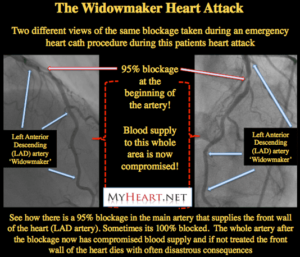When it comes to the heart, time is critical. Blood carries oxygen to the body. When blood flow is blocked, cells can die. The more time that passes before treatment, the bigger the risk of death.
A complete blockage in the main artery that feeds the front and side walls of the heart and the septum, a muscular boundary between the left and right chambers.
“That’s a big deal” ,says Dr. Todd Caulfield, the Providence interventional cardiologist who operates on patient’s like this. “People call this the widow maker.”, he states. Nationwide about 300,000 people suffer cardiac arrest outside a hospital every year, according to the federal Centers for Disease Control and Prevention. Only 8 percent survive.
The heart pumps blood to the body and brain. The heart also needs blood so it pumps blood to itself, too. The heart’s blood supply is essentially three main arteries: one that goes to the front; the other that goes to the back; and the final artery that connects to the side of the heart. When one of those arteries is blocked, the heart doesn’t get enough blood and oxygen, causing a heart attack. This is simply due to the block that doesn’t allow oxygen to the heart tissue that that artery feeds oxygenated blood. This causes ischemia (lack of oxygen perfusion to tissue). It causes pain first (chest pain=angina) and if the block continues than it will lead to infarction meaning death of the tissue not receiving enough (partial block) or no oxygen (a complete block). The exact same thing happens in the brain, which causes a stroke; or the foot causing first pain leading to blackish skin of the foot tissue=necrotic tissue which ends up being amputated (like in some patients with diabetes or peripheral vascular disease). So lack of oxygen to our tissue parts anywhere can cause death to the tissue and depending on the tissue area cause death (like with the heart, due to the heart being the engine of the human body).
Interventional Cardiologist Randy Goodroe says patients are getting treatment quicker for heart attacks, more now than ever before. So the once grim reality of suffering from “the widowmaker” – a heart attack that results in immediate death – has become somewhat of a misnomer.
It’s called a “widowmaker”, Dr. Goodroe added, because it would typically kill you if the artery doesn’t get opened fast enough.
There are two different kinds of heart attacks. One is called an ST-elevation myocardial infarction, or STEMI, where the artery is totally blocked (i.e. the widowmaker), and we are on the clock to get the artery opened as soon as possible. There’s also a non-ST-elevation myocardial infarction (NSTEMI) where an artery is partially or temporarily blocked, and is still urgent to get the artery cleared, but not emergent.
Common Risk Factors:
Age is definitely a risk factor. We start seeing coronary disease in people who are between 50 and 60-years-old, and obviously, the older the person, the older the arteries, the higher the risk. Diabetes is another one of the greatest risk factors. Smoking is the strongest modifiable risk factor, meaning it’s the worst thing people can do to themselves to accelerate the disease process. High blood pressure and family history are also risk factors for heart attacks.
How to detect it if in the ER with symptoms & than repair it:
If a patient enters the ER with heart attack symptoms, quickly performed is an electrocardiogram (EKG) including cardiac enzymes to and echocardiogram or stress test to detect a totally obstructed artery. The artery is like a pipe or a tube., so we put a tiny wire through the blockageThose patients are very quickly taken to the cardiac catheterization lab where an angiogram is done to detect if there is and how bad the blockage is, if present. Than with an angioplasty (balloons) at the end of the angiogram catheter break up the blockage and stents inserted in the area of blockage to get the blood flowing to the heart again. The balloon is taken out and a stent is slid over that also has a balloon on it and once the stent goes up, it props open the blockage. Blockage is repaired.

